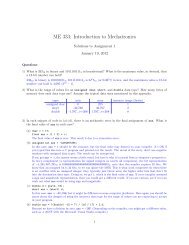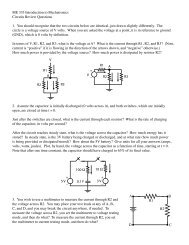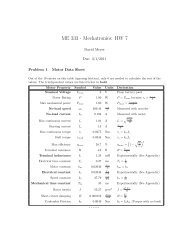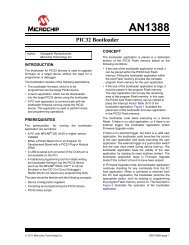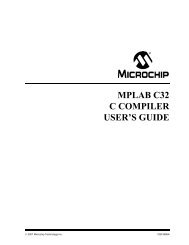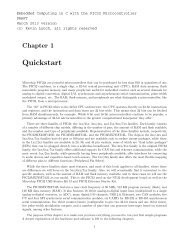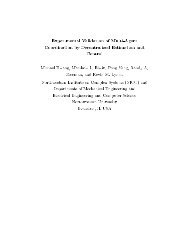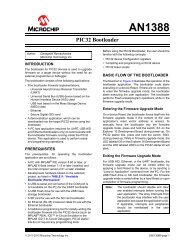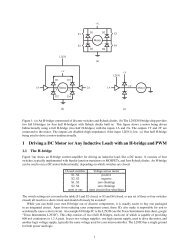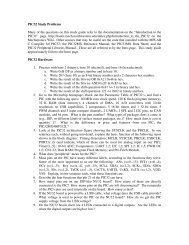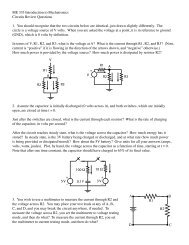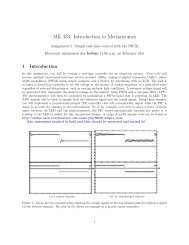- Page 1 and 2: dsPIC33FJ12MC201/202Data SheetHigh-
- Page 3 and 4: dsPIC33FJ12MC201/202High-Performanc
- Page 5 and 6: dsPIC33FJ12MC201/202dsPIC33FJ12MC20
- Page 7 and 8: dsPIC33FJ12MC201/202Pin Diagrams (C
- Page 9 and 10: dsPIC33FJ12MC201/2021.0 DEVICE OVER
- Page 11 and 12: dsPIC33FJ12MC201/202TABLE 1-1:Pin N
- Page 13 and 14: dsPIC33FJ12MC201/2021.1 Referenced
- Page 15 and 16: dsPIC33FJ12MC201/2022.0 GUIDELINES
- Page 17 and 18: dsPIC33FJ12MC201/2022.5 ICSP PinsTh
- Page 19 and 20: dsPIC33FJ12MC201/2023.0 CPUNote 1:
- Page 21 and 22: dsPIC33FJ12MC201/202FIGURE 3-2:dsPI
- Page 23 and 24: dsPIC33FJ12MC201/202REGISTER 3-1:SR
- Page 25 and 26: dsPIC33FJ12MC201/2023.5 Arithmetic
- Page 27: dsPIC33FJ12MC201/2023.6.1 MULTIPLIE
- Page 31 and 32: dsPIC33FJ12MC201/2024.0 MEMORY ORGA
- Page 33 and 34: dsPIC33FJ12MC201/2024.2 Data Addres
- Page 35 and 36: dsPIC33FJ12MC201/2024.2.5 X AND Y D
- Page 37 and 38: © 2007-2011 Microchip Technology I
- Page 39 and 40: © 2007-2011 Microchip Technology I
- Page 41 and 42: © 2007-2011 Microchip Technology I
- Page 43 and 44: © 2007-2011 Microchip Technology I
- Page 45 and 46: © 2007-2011 Microchip Technology I
- Page 47 and 48: © 2007-2011 Microchip Technology I
- Page 49 and 50: dsPIC33FJ12MC201/202TABLE 4-26:FUND
- Page 51 and 52: dsPIC33FJ12MC201/2024.4.3 MODULO AD
- Page 53 and 54: dsPIC33FJ12MC201/2024.6 Interfacing
- Page 55 and 56: dsPIC33FJ12MC201/2024.6.2 DATA ACCE
- Page 57 and 58: dsPIC33FJ12MC201/2025.0 FLASH PROGR
- Page 59 and 60: dsPIC33FJ12MC201/202REGISTER 5-1:NV
- Page 61 and 62: dsPIC33FJ12MC201/2025.4.1 PROGRAMMI
- Page 63 and 64: dsPIC33FJ12MC201/2026.0 RESETSNote
- Page 65 and 66: dsPIC33FJ12MC201/202REGISTER 6-1:RC
- Page 67 and 68: dsPIC33FJ12MC201/202FIGURE 6-2:SYST
- Page 69 and 70: dsPIC33FJ12MC201/2026.4 External Re
- Page 71 and 72: dsPIC33FJ12MC201/2027.0 INTERRUPT C
- Page 73 and 74: dsPIC33FJ12MC201/202TABLE 7-1:Vecto
- Page 75 and 76: dsPIC33FJ12MC201/2027.3 Interrupt C
- Page 77 and 78: dsPIC33FJ12MC201/202REGISTER 7-3: I
- Page 79 and 80:
dsPIC33FJ12MC201/202REGISTER 7-4: I
- Page 81 and 82:
dsPIC33FJ12MC201/202REGISTER 7-5:IF
- Page 83 and 84:
dsPIC33FJ12MC201/202REGISTER 7-7: I
- Page 85 and 86:
dsPIC33FJ12MC201/202REGISTER 7-9: I
- Page 87 and 88:
dsPIC33FJ12MC201/202REGISTER 7-10:
- Page 89 and 90:
dsPIC33FJ12MC201/202REGISTER 7-12:
- Page 91 and 92:
dsPIC33FJ12MC201/202REGISTER 7-14:
- Page 93 and 94:
dsPIC33FJ12MC201/202REGISTER 7-16:
- Page 95 and 96:
dsPIC33FJ12MC201/202REGISTER 7-18:
- Page 97 and 98:
dsPIC33FJ12MC201/202REGISTER 7-20:
- Page 99 and 100:
dsPIC33FJ12MC201/202REGISTER 7-23:
- Page 101 and 102:
dsPIC33FJ12MC201/2027.4 Interrupt S
- Page 103 and 104:
dsPIC33FJ12MC201/2028.0 OSCILLATORC
- Page 105 and 106:
dsPIC33FJ12MC201/2028.1.3 PLL CONFI
- Page 107 and 108:
dsPIC33FJ12MC201/202REGISTER 8-1: O
- Page 109 and 110:
dsPIC33FJ12MC201/202REGISTER 8-2: C
- Page 111 and 112:
dsPIC33FJ12MC201/202REGISTER 8-4: O
- Page 113 and 114:
dsPIC33FJ12MC201/2029.0 POWER-SAVIN
- Page 115 and 116:
dsPIC33FJ12MC201/202REGISTER 9-1: P
- Page 117 and 118:
dsPIC33FJ12MC201/202REGISTER 9-3: P
- Page 119 and 120:
dsPIC33FJ12MC201/20210.0 I/O PORTSN
- Page 121 and 122:
dsPIC33FJ12MC201/20210.4 Peripheral
- Page 123 and 124:
dsPIC33FJ12MC201/202TABLE 10-2:OUTP
- Page 125 and 126:
dsPIC33FJ12MC201/202REGISTER 10-2:
- Page 127 and 128:
dsPIC33FJ12MC201/202REGISTER 10-4:
- Page 129 and 130:
dsPIC33FJ12MC201/202REGISTER 10-6:
- Page 131 and 132:
dsPIC33FJ12MC201/202REGISTER 10-9:
- Page 133 and 134:
dsPIC33FJ12MC201/202REGISTER 10-11:
- Page 135 and 136:
dsPIC33FJ12MC201/202REGISTER 10-13:
- Page 137 and 138:
dsPIC33FJ12MC201/202REGISTER 10-16:
- Page 139 and 140:
dsPIC33FJ12MC201/202REGISTER 10-20:
- Page 141 and 142:
dsPIC33FJ12MC201/20211.0 TIMER1Note
- Page 143 and 144:
dsPIC33FJ12MC201/20212.0 TIMER2/3 F
- Page 145 and 146:
dsPIC33FJ12MC201/202FIGURE 12-2:TIM
- Page 147 and 148:
dsPIC33FJ12MC201/202REGISTER 12-2:T
- Page 149 and 150:
dsPIC33FJ12MC201/20213.0 INPUT CAPT
- Page 151 and 152:
dsPIC33FJ12MC201/20214.0 OUTPUT COM
- Page 153 and 154:
dsPIC33FJ12MC201/202FIGURE 14-2:OUT
- Page 155 and 156:
dsPIC33FJ12MC201/20215.0 MOTOR CONT
- Page 157 and 158:
dsPIC33FJ12MC201/202FIGURE 15-2:2-C
- Page 159 and 160:
dsPIC33FJ12MC201/202REGISTER 15-2:P
- Page 161 and 162:
dsPIC33FJ12MC201/202REGISTER 15-5:
- Page 163 and 164:
dsPIC33FJ12MC201/202REGISTER 15-7:
- Page 165 and 166:
dsPIC33FJ12MC201/202REGISTER 15-9:
- Page 167 and 168:
dsPIC33FJ12MC201/202REGISTER 15-11:
- Page 169 and 170:
dsPIC33FJ12MC201/20216.0 QUADRATURE
- Page 171 and 172:
dsPIC33FJ12MC201/202REGISTER 16-1:Q
- Page 173 and 174:
dsPIC33FJ12MC201/20217.0 SERIAL PER
- Page 175 and 176:
dsPIC33FJ12MC201/202REGISTER 17-2:
- Page 177 and 178:
dsPIC33FJ12MC201/202REGISTER 17-3:
- Page 179 and 180:
dsPIC33FJ12MC201/20218.0 INTER-INTE
- Page 181 and 182:
dsPIC33FJ12MC201/202REGISTER 18-1:I
- Page 183 and 184:
dsPIC33FJ12MC201/202REGISTER 18-2:I
- Page 185 and 186:
dsPIC33FJ12MC201/202REGISTER 18-3:I
- Page 187 and 188:
dsPIC33FJ12MC201/20219.0 UNIVERSAL
- Page 189 and 190:
dsPIC33FJ12MC201/202REGISTER 19-1:U
- Page 191 and 192:
dsPIC33FJ12MC201/202REGISTER 19-2:U
- Page 193 and 194:
dsPIC33FJ12MC201/20220.0 10-BIT/12-
- Page 195 and 196:
dsPIC33FJ12MC201/202FIGURE 20-2:ADC
- Page 197 and 198:
dsPIC33FJ12MC201/202REGISTER 20-1:
- Page 199 and 200:
dsPIC33FJ12MC201/202REGISTER 20-2:
- Page 201 and 202:
dsPIC33FJ12MC201/202REGISTER 20-4:A
- Page 203 and 204:
dsPIC33FJ12MC201/202REGISTER 20-5:A
- Page 205 and 206:
dsPIC33FJ12MC201/20221.0 SPECIAL FE
- Page 207 and 208:
dsPIC33FJ12MC201/202TABLE 21-2:Bit
- Page 209 and 210:
dsPIC33FJ12MC201/20221.4 Watchdog T
- Page 211 and 212:
dsPIC33FJ12MC201/20222.0 INSTRUCTIO
- Page 213 and 214:
dsPIC33FJ12MC201/202TABLE 22-1:Fiel
- Page 215 and 216:
dsPIC33FJ12MC201/202TABLE 22-2:Base
- Page 217 and 218:
dsPIC33FJ12MC201/202TABLE 22-2:Base
- Page 219 and 220:
dsPIC33FJ12MC201/20223.0 DEVELOPMEN
- Page 221 and 222:
dsPIC33FJ12MC201/20223.7 MPLAB SIM
- Page 223 and 224:
dsPIC33FJ12MC201/20224.0 ELECTRICAL
- Page 225 and 226:
dsPIC33FJ12MC201/202TABLE 24-4: DC
- Page 227 and 228:
dsPIC33FJ12MC201/202TABLE 24-6: DC
- Page 229 and 230:
dsPIC33FJ12MC201/202TABLE 24-9:DC C
- Page 231 and 232:
dsPIC33FJ12MC201/202TABLE 24-9:DC C
- Page 233 and 234:
dsPIC33FJ12MC201/202TABLE 24-12: DC
- Page 235 and 236:
dsPIC33FJ12MC201/202FIGURE 24-2:EXT
- Page 237 and 238:
dsPIC33FJ12MC201/202FIGURE 24-3:CLK
- Page 239 and 240:
dsPIC33FJ12MC201/202TABLE 24-21:AC
- Page 241 and 242:
dsPIC33FJ12MC201/202TABLE 24-23:AC
- Page 243 and 244:
dsPIC33FJ12MC201/202TABLE 24-26: IN
- Page 245 and 246:
dsPIC33FJ12MC201/202TABLE 24-29: MO
- Page 247 and 248:
dsPIC33FJ12MC201/202TABLE 24-31:AC
- Page 249 and 250:
dsPIC33FJ12MC201/202TABLE 24-33: SP
- Page 251 and 252:
dsPIC33FJ12MC201/202FIGURE 24-17:SP
- Page 253 and 254:
dsPIC33FJ12MC201/202TABLE 24-36:AC
- Page 255 and 256:
dsPIC33FJ12MC201/202TABLE 24-37:AC
- Page 257 and 258:
dsPIC33FJ12MC201/202TABLE 24-38:AC
- Page 259 and 260:
dsPIC33FJ12MC201/202TABLE 24-39:AC
- Page 261 and 262:
dsPIC33FJ12MC201/202TABLE 24-40: I2
- Page 263 and 264:
dsPIC33FJ12MC201/202TABLE 24-41:I2C
- Page 265 and 266:
dsPIC33FJ12MC201/202TABLE 24-43: AD
- Page 267 and 268:
dsPIC33FJ12MC201/202FIGURE 24-26:AD
- Page 269 and 270:
dsPIC33FJ12MC201/2023.0 TAD — Aut
- Page 271 and 272:
dsPIC33FJ12MC201/20225.0 PACKAGING
- Page 273 and 274:
dsPIC33FJ12MC201/20225.2 Package De
- Page 275 and 276:
dsPIC33FJ12MC201/202Note:For the mo
- Page 277 and 278:
dsPIC33FJ12MC201/202Note:For the mo
- Page 279 and 280:
dsPIC33FJ12MC201/20228-Lead Skinny
- Page 281 and 282:
dsPIC33FJ12MC201/202Note:For the mo
- Page 283 and 284:
dsPIC33FJ12MC201/202Note:For the mo
- Page 285 and 286:
dsPIC33FJ12MC201/20228-Lead Plastic
- Page 287 and 288:
dsPIC33FJ12MC201/202APPENDIX A:Revi
- Page 289 and 290:
dsPIC33FJ12MC201/202TABLE 25-1:Sect
- Page 291 and 292:
dsPIC33FJ12MC201/202TABLE 25-1:Sect
- Page 293 and 294:
dsPIC33FJ12MC201/202TABLE 25-1:Sect
- Page 295 and 296:
dsPIC33FJ12MC201/202TABLE 25-3:MAJO
- Page 297 and 298:
dsPIC33FJ12MC201/202INDEXAAC Charac
- Page 299 and 300:
dsPIC33FJ12MC201/202IPC3 (Interrupt
- Page 301 and 302:
dsPIC33FJ12MC201/202THE MICROCHIP W
- Page 303 and 304:
dsPIC33FJ12MC201/202PRODUCT IDENTIF



